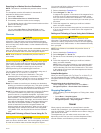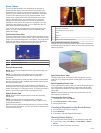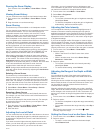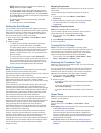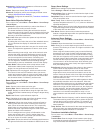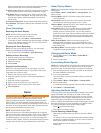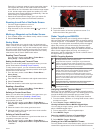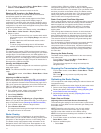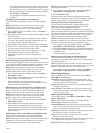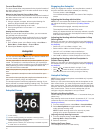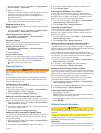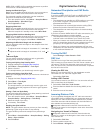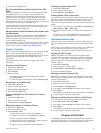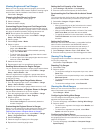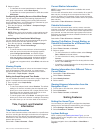
1
From a Radar screen, select Menu > Radar Menu > Other
Vessels > AIS & MARPA List > Show.
2
Select the type of threats to include in the list.
Showing AIS Vessels on the Radar Screen
AIS requires the use of an external AIS device and active
transponder signals from other vessels.
You can configure how other vessels appear on the Radar
screen. If any setting (except the AIS display range) is
configured for one radar mode, the setting is applied to every
other radar mode. The details and projected heading settings
configured for one radar mode are applied to every other radar
mode and to the Radar overlay.
1
From a Radar screen or the Radar overlay, select Menu >
Radar Menu > Other Vessels > Display Setup.
2
Select an option:
• To indicate the distance from your location within which
AIS vessels appear, select Display Range, and select a
distance.
• To show details about AIS-activated vessels, select
Details > Show.
• To set the projected heading time for AIS-activated
vessels, select Projected Heading, and enter the time.
VRM and EBL
The variable range marker (VRM) and the electronic bearing
line (EBL) measure the distance and bearing from your boat to
a target object. On the Radar screen, the VRM appears as a
circle that is centered on the present location of your boat, and
the EBL appears as a line that begins at the present location of
your boat and intersects the VRM. The point of intersection is
the target of the VRM and the EBL.
Showing the VRM and the EBL
The VRM and the EBL configured for one mode are applied to
other radar modes.
NOTE: The VRM and the EBL cannot be changed in sentry
mode.
From a Radar screen, select Menu > Radar Menu > Show
VRM/EBL.
Adjusting the VRM and the EBL
Before you can adjust the VRM and the EBL, you must show
them on the Radar screen (Showing the VRM and the EBL).
You can adjust the diameter of the VRM and the angle of the
EBL, which moves the intersection point of the VRM and the
EBL. The VRM and the EBL configured for one mode are
applied to all other radar modes.
1
From a Radar screen, select a new location for the
intersection point of the VRM and the EBL.
2
Select Drop VRM/EBL.
3
Select Stop Pointing.
Measuring the Range and Bearing to a Target Object
Before you can adjust the VRM and the EBL, you must show
them on the Radar screen (Showing the VRM and the EBL).
1
From a Radar screen, select the target location.
2
Select Measure Distance.
The range and the bearing to the target location appear in
the upper-left corner of the screen.
Radar Overlay
When you connect your chartplotter to an optional Garmin
marine radar, you can use the Radar overlay to overlay radar
information on the Navigation chart or on the Fishing chart.
The Radar overlay superimposes radar information on the
Navigation chart or the Fishing chart. Data appears on the
Radar overlay based on the most recently used radar mode
(such as Harbor, Offshore, or Sentry), and all settings
configurations applied to the Radar overlay are also applied to
the last-used radar mode. For example, if you use Harbor mode
and then you switch to the Radar overlay, the Radar overlay
would show Harbor mode radar data. If you changed the gain
setting using the Radar overlay menu, the gain setting for
Harbor mode would change automatically.
Radar Overlay and Chart Data Alignment
When using the Radar overlay, the chartplotter aligns radar data
with chart data based on the boat heading, which is based by
default on data from a magnetic heading sensor connected
using a NMEA 0183 or NMEA 2000 network. If a heading
sensor is not available, the boat heading is based on GPS
tracking data.
GPS tracking data indicates the direction in which the boat is
moving, not the direction in which the boat is pointing. If the
boat is drifting backward or sideways due to a current or wind,
the Radar overlay may not perfectly align with the chart data.
This situation should be avoided by using boat-heading data
from an electronic compass.
If the boat heading is based on data from a magnetic heading
sensor or an automatic pilot, the heading data could be
compromised due to incorrect setup, mechanical malfunction,
magnetic interference, or other factors. If the heading data is
compromised, the Radar overlay may not align perfectly with
the chart data.
Showing the Radar Overlay
The Radar overlay displays data based on the most recently
used radar mode.
From a Radar screen, select Menu > Radar Menu >
Change Radar > Radar Overlay.
The radar picture appears in orange and overlays the
Navigation chart.
Stopping the Transmission of Radar Signals
From a Radar screen, select Menu > Radar Menu > Radar
to Standby.
TIP: Press from any screen to quickly stop radar
transmission.
Optimizing the Radar Display
You can adjust the radar display settings for reduced clutter and
increased accuracy.
NOTE: You can optimize the radar display for each radar mode.
1
Select a radar range (Adjusting the Radar Range).
2
Restore the default value of the gain setting (Adjusting Gain
on the Radar Screen Automatically).
3
Adjust the gain setting manually (Adjusting Gain on the
Radar Screen Manually).
Radar Gain and Clutter
Adjusting Gain on the Radar Screen Automatically
The automatic gain setting for each radar mode is optimized for
that mode, and may differ from the automatic gain setting used
for another mode.
NOTE: Depending upon the radar in use, the gain setting
configured for use in one radar mode may or may not be
applied to other radar modes or to the Radar overlay.
NOTE: Not all options and settings are available on all radar
and chartplotter models.
1
From a Radar screen or the Radar overlay, select Menu >
Radar Menu > Gain.
2
Select an available option:
• Select Auto.
18 Radar




